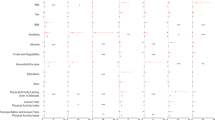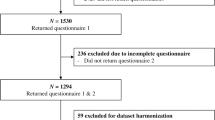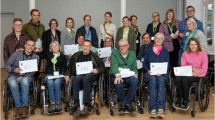Abstract
Study design:
Meta-analysis of cross-sectional, quasi-experimental and experimental studies.
Objective:
To determine if there is an association between physical activity (PA) and subjective well-being (SWB) among people living with spinal cord injury (SCI).
Methods:
Literature searches were conducted using multiple databases (Embase, CINAHL, Medline, PsychINFO and SPORTDiscus) to identify studies involving people with SCI that included a measure of PA and at least one measure of SWB (for example, symptoms of depression, life satisfaction, mood). Relevant data were extracted from the studies and subjected to meta-analysis.
Results:
A total of 21 studies were retrieved yielding 78 effect sizes and a total sample size of 2354. Overall, there were statistically significant, small- to medium-sized effects for the relationships between PA and SWB (broadly defined), PA and depressive symptoms, and PA and life satisfaction. Studies using experimental and quasi-experimental designs yielded larger effects for SWB (broadly defined) and life satisfaction, than studies using nonexperimental study designs.
Conclusions:
There is a small- to medium-sized positive relationship between PA and SWB among people with SCI that holds across a wide range of measures and operational definitions of these constructs.
Similar content being viewed by others
Log in or create a free account to read this content
Gain free access to this article, as well as selected content from this journal and more on nature.com
or
References
Diener E, Suh EM, Lucas RE, Smith HL . Subjective well-being: three decades of progress. Psych Bull 1999; 125: 276–302.
Dijkers M . Quality of life after spinal cord injury: a meta analysis of the effects of disablement components. Spinal Cord 1997; 35: 829–840.
Dijkers MP . Quality of life of individuals with spinal cord injury: a review of conceptualization, measurement, and research findings. J Rehabil Res Dev 2005; 42: 87–110.
Evans RL, Hendricks RD, Connis RT, Haselkorn JK, Ries KR, Mennet TE . Quality of life after spinal cord injury: a literature critique and meta-analysis (1983–1992). J Am Paraplegia Soc 1994; 17: 60–66.
Lox CL, Martin KA, Petruzzello SJ . The Psychology of Exercise: Integrating Theory and Practice. Holcomb Hathaway Publishers: Scottsdale, AZ, 2006.
Lawlor DA, Hopker SW . The effectiveness of exercise as an intervention in the management of depression: systematic review and meta-regression analysis of randomised controlled trials. BMJ 2001; 322: 763–767.
Reed J, Ones DS . The effect of acute aerobic exercise on positive activated affect: a meta-analysis. Psych Sport Exerc 2006; 7: 477–514.
Gillison FB, Skevington SM, Sato A, Standage M, Evagelidou S . The effects of exercise interventions on quality of life in clinical and healthy populations; a meta-analysis. Soc Sci Med 2009; 68: 1700–1710 .
Hicks AL, Martin KA, Ditor DS, Latimer AE, Craven C, Bugaresti J et al. Long-term exercise training in persons with spinal cord injury: effects on strength, arm ergometry performance and psychological well-being. Spinal Cord 2003; 41: 34–43.
Ditor DS, Latimer AE, Martin Ginis KA, Arbour KP, McCartney N, Hicks AL . Maintenance of exercise participation in individuals with spinal cord injury: effects on quality of life, stress and pain. Spinal Cord 2003; 41: 446–450.
Foreman PE, Cull J, Kirkby RJ . Sports participation in individuals with spinal cord injury: demographic and psychological correlates. Int J Rehabil Res 1997; 20: 159–168.
Tasiemski T, Kennedy P, Gardner BP, Taylor N . The association of sports and physical recreation with life satisfaction in a community sample of people with spinal cord injuries. Neurorehabilitation 2005; 20: 253–265.
Kennedy P, Taylor N, Hindson L . A pilot investigation of a psychosocial activity course for people with spinal cord injuries. Psych Health Med 2006; 11: 91–99.
Landers DM, Arent SM . Physical activity and mental health. In Tenenbaum G, Eklund RC (eds). Handbook of Sport Psychology. Wiley: Hoboken, NJ, 2007 pp 469–491.
Cohen J . A power primer. Psych Bull 1992; 112: 155–159.
Martin Ginis KA, Hicks AL . Exercise research issues in the spinal cord injured population. Exerc Sport Sci Rev 2004; 33: 49–53.
Higgins JP, Thompson SG, Deeks JJ, Altman DG . Measuring inconsistency in meta-analyses. BMJ 2003; 327: 557–560.
Caspersen CJ, Powell KE, Christenson GM . Physical-activity, exercise, and physical-fitness—definitions and distinctions for health-related research. Pub Health Rep 1985; 100: 126–131.
Hunter JE, Schmidt FL . Methods of Meta-analysis: Correcting Error and Bias in Research Findings. Thousand Oaks: Sage, 2004.
Borenstein M, Heges LV, Higgins JPT, Rothstein HR . Introduction to Meta-analysis. Wiley: Hoboken, NJ, 2009.
Ones DS, Viswesvaran C, Schmidt FL . Comprehensive metaanalysis of integrity test validities—findings and implications for personnel-selection and theories of job-performance. J Appl Psych 1993; 78: 679–703.
Dishman RK, Washburn RA, Heath GW . Physical Activity Epidemiology. Human Kinetics: Champaign, IL, 2004.
Chaouloff F . The serotonin hypothesis. In: Morgan WP (ed). Physical Activity and Mental Health. Taylor & Francis: Washington, DC, 1997, pp 179–198.
Dishman RK . The norepinephrine hypothesis. In: Morgan WP (ed). Physical Activity and Mental Health. Taylor & Francis: Washington, DC, 1997 pp 199–212.
Martin Ginis KA, Latimer AE, McKecknie K, Ditor DS, McCartney N, Hicks AL et al. Using exercise to enhance subjective well-being among people with spinal cord injury: the mediating influences of stress and pain. Rehab Psych 2003; 48: 157–164.
Hallin P, Sullivan M, Kreuter M . Spinal cord injury and quality of life measures: a review of instrument psychometric quality. Spinal Cord 2000; 38: 509–523.
Krause JS . Dimensions of subjective well-being after spinal cord injury: an empirical analysis by gender and race/ethnicity. Arch Phys Med Rehabil 1998; 79: 900–909.
Martin Ginis KA, Latimer AE, Craven BC, Hicks AL . Development and preliminary evaluation of an activity measure for people with spinal cord injury. Med Sci Sports Exerc 2005; 37: 1099–1111.
Latimer AE, Martin Ginis KA, Craven BC, Hicks AL . The physical activity recall assessment for individuals with SCI: validity. Med Sci Sports Exerc 2006; 38: 208–216.
Martin Ginis KA, Hicks AL . Considerations for the development of a physical activity guide for Canadians with physical disabilities. Can J Pub Health 2007; 98 (Suppl 2): S135–S147.
Acknowledgements
We thank two anonymous reviewers who provided comprehensive feedback on previous versions this paper. Feedback from Reviewer A resulted in a substantial narrowing of the scope of our meta-analysis and the subsequent exclusion of several studies that were not aligned with the reviewer's definition of subjective well-being. Although removal of these studies had minimal effect on the overall robs, exclusion of these studies did improve the symmetry of the data and narrowed the confidence intervals. Investigators who use alternative conceptualizations of subjective well-being in future meta-analytic reviews may yield somewhat different results from those reported herein. This study was sponsored by a Canadian Institutes of Health Research New Investigator Award awarded to KA Martin Ginis.
Author information
Authors and Affiliations
Corresponding author
Appendices
Appendix A
Physical activity search terms: physical activity, sport, exercise, fitness, training, exercise adherence, leisure, functional electrical stimulation (FES), body-weight supported treadmill training (BWSTT), standing, ambulation, endurance capacity.
Subjective well-being search terms: subjective well-being, quality of life (QOL), life satisfaction, satisfaction, stress, physical self-concept, depression, anxiety, vigor, mood, perceived health, affect, well-being, confusion, fatigue, hostility, anger, health-related quality of life (HRQOL), body image, self-concept, tension.
Appendix B
Studies included in the meta-analysis that are not referenced above
Bradley M. The effect of participating in a functional electrical stimulation exercise program on affect in people with spinal cord injuries. Arch Phys Med Rehabil 1994; 75: 676-679.
Eng JJ, Levins SM, Townson AF, Mah-Jones D, Bremner J, Huston G. Use of prolonged standing for individuals with spinal cord injuries. Phys Ther 2001; 81: 1392-1399.
Gioia MC, Cerasa A, Di Lucente L, Brunelli S, Castellano V, Traballesi M. Psychological impact of sports activity in spinal cord injury patients. Scand J Med Sci Sports 2006; 16: 412-416.
Greenwood M, Dzewaltoski D, French R. Self-efficacy and psychological well-being of wheelchair tennis participants and wheelchair nontennis participants. Adapt Phys Activ Quart 1990; 7: 12-21.
Guest E, Klose J, Needham-Shropshire M, Jacobs P. Evaluation of a training program for persons with SCI paraplegia using parastep 1 ambulation system: part 4. Effect on physical self-concept and depression. Arch Phys Med Rehabil 1997; 78: 804-807.
Hicks AL, Adams MM, Martin Ginis K, Giangregorio L, Latimer A, Phillips SM et al. Long-term body-weight-supported treadmill training and subsequent follow-up in persons with chronic SCI: effects on functional walking ability and measures of subjective well-being. Spinal Cord 2005; 43: 291-8.
Jacobs D, Roswal G, Horuat M, Gorman D. A comparison between the psychological profiles of wheelchair athletes, wheelchair nonathletes and able-bodied athletes. In Doll-Tepper G, Dahms C, Doll B, von Selzam H (eds.). Adapted Physical Activity—An Interdisciplinary Approach. Springer-Verlag: Heidelberg 1990, pp. 75-79.
Loy D, Dattilo J. Exploring the influence of leisure on adjustment: development of leisure and spinal cord injury adjustment model. Leisure Sci 2003; 25: 231-255.
Manns PJ, Chad KE. Determining the relation between quality of life, handicap, fitness, and physical activity for persons with spinal cord injury. Arch Phys Med Rehabil 1999; 80: 1566-1571.
Muraki S, Tsunawake N, Hiramatsu S, Yamasaki M. The effect of frequency and mode of sports activity on the psychological status in tetraplegics and paraplegics. Spinal Cord 2000; 38: 309-314.
Nawoczenski DA, Ritter-Soronen JM, Wilson CM, Howe BA, Ludewig PM. Clinical trial of exercise for shoulder pain in chronic spinal injury. Phys Ther 2006; 86:1604-1618.
Paulsen P, French R, Sherrill C. Comparison of wheelchair athletes and nonathletes on selected mood states. Percept Mot Skills 1990; 71: 1160-1162.
Semerjian TZ, Montague SM, Dominguez JF, Davidian AM, de Leon RD. Enhancement of quality of life and body satisfaction through the use of adapted exercises devices for individuals with spinal cord injuries. Top Spinal Cord Inj Rehabil 2005; 11: 95-108.
Sipski ML, Delisa JA, Schweer S. Functional electrical stimulation bicycle ergometry: patient perceptions. Am J Phys Med Rehabil 1989; 68:147-149.
Walter J, Sola P, Sacks J, Lucero Y, Langbein E, Weaver F. Indications for a home standing program for individuals with spinal cord injury. J Spinal Cord Med 1999; 22: 152-158.
Warms CA, Belza BL, Whitney JD, Mitchell PH, Stiens SA. Lifestyle physical activity for individuals with spinal cord injury: a pilot study. Am J Health Promot 2004; 18: 288-291.
Rights and permissions
About this article
Cite this article
Martin Ginis, K., Jetha, A., Mack, D. et al. Physical activity and subjective well-being among people with spinal cord injury: a meta-analysis. Spinal Cord 48, 65–72 (2010). https://doi.org/10.1038/sc.2009.87
Received:
Revised:
Accepted:
Published:
Issue date:
DOI: https://doi.org/10.1038/sc.2009.87
Keywords
This article is cited by
-
The effects of active upper-limb versus passive lower-limb exercise on quality of life among individuals with motor-complete spinal cord injury
Spinal Cord (2022)
-
Novel velocity estimation for symmetric and asymmetric self-paced treadmill training
Journal of NeuroEngineering and Rehabilitation (2021)
-
Functional electrical stimulation cycling exercise after spinal cord injury: a systematic review of health and fitness-related outcomes
Journal of NeuroEngineering and Rehabilitation (2021)
-
The Spinal Cord Injury Program in Exercise (SCIPE) study: study protocol for a randomized controlled trial evaluating teleexercise programs for people with spinal cord injury
Trials (2021)
-
Construct validation of the leisure time physical activity questionnaire for people with SCI (LTPAQ-SCI)
Spinal Cord (2021)



